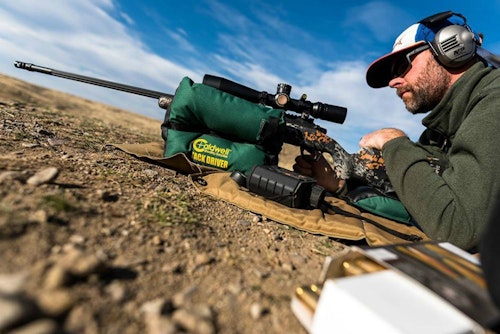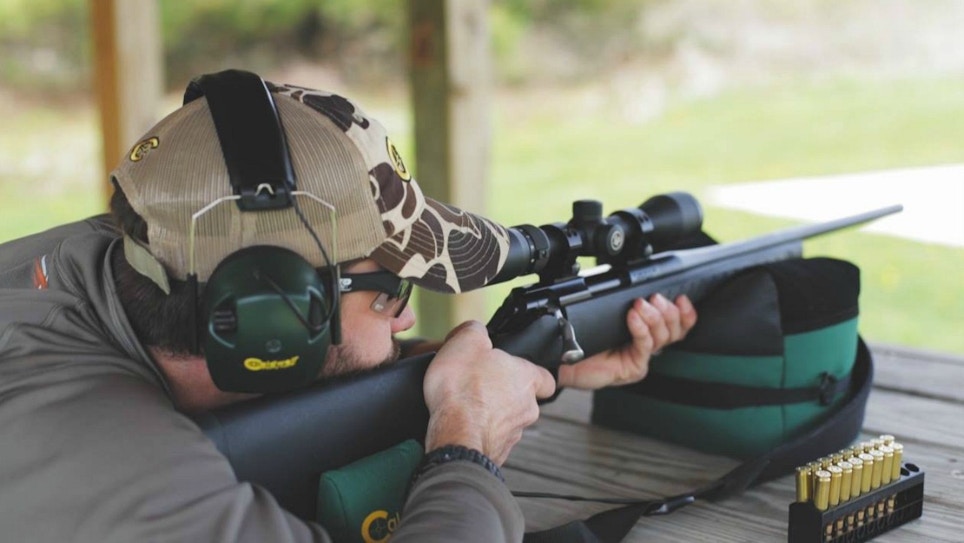I won’t stand on a soap box and preach that you must confirm bullet/slug impact of your firearm if you traveled to deer camp in your vehicle, or a buddy’s truck, and took reasonable care of your gun case along the way. If your firearm/scope combo can’t keep its zero under these tame circumstances, you need to rethink your scope mounting system, purchase a better scope, or both.
However, if you must hand over your cased firearm to airline baggage handlers, then it’s wise to confirm projectile impact after reaching deer camp. You have no idea whether airline staff was careful with your gun case. You owe it to a whitetail buck to confirm your gun’s zero.
Tip No. 1: Insist on Sandbags
Confirm with your outfitter in the months leading up to your hunt that he has an area for sighting-in firearms. Don’t expect a fancy range, but it should be at least a picnic table or something similar that you can use for a shooting bench. Confirm that he has a variety of sandbags available. Large sandbags are best for supporting your gun’s forearm. Support the rear of your gun on a smaller sandbag. Ideally, your gun should sit in place — on target — without you holding it. A secure setup such as this virtually eliminates human interference. Simply slip in behind the supported gun, make sure the butt stock contacts your shoulder, aim and then slowly press the trigger to the rear.

Tip No. 2: Find Your Close-Range Zero
In the months leading up to your deer hunt, be sure to sight-in at various distances. For example, many deer hunters like to have their rifles impact 1-2 inches high at 100 yards, which means they are hitting the bull’s-eye at 200, 225 or 250 yards; this yardage varies depending on cartridge and bullet choice. One thing that doesn’t vary, however, is your bullet crosses your scope’s line-of-sight twice: once at relatively close range and then again at your long-range zero (for example, 200 or 250 yards). Through experimentation at home, find this close-range zero. It will be close to 25 yards, give or take a yard or two.
The reason to find your close-range zero is you won’t have to worry about trying to sight-in at 100, 200 or 250 yards at deer camp if conditions are less than ideal. For example, what if the winds are blowing 40 mph when you arrive at deer camp? This isn’t ideal for sighting-in a gun. What if it’s dark? It’s hard to shoot 100 yards or more in the dark. However, setting up a 25-yard range is simple. In a pinch, it can be done using nothing more than the ground (shooting prone), hopefully sandbags (but a backpack could work), a couple flashlights and a tissue box with a 1-inch bull’s-eye for a target.
Tip No. 3: Bring Tools and Extra Ammo
In a worst case scenario, you’re gun isn’t hitting close to where it did at home. Step No. 1 is tightening all scope mounting screws. Don’t trust that your outfitter or guide has the tools for your rig. Next, shoot at close range; specifically, your close-range zero (about 25 yards). Don’t shoot at 100 yards until you can hit a dime-size spot repeatedly from 25 yards. After you’re confident at 25 yards, move out to 100 yards and adjust your scope accordingly (1.5-2 inches high, etc.).
Of course, none of this will be possible if you show up to deer camp with one box of ammo. Plan for the worst: Pack one box for hunting, and two boxes for sighting-in at deer camp. Hopefully you won’t need it. However, few things are as stressful as having limited ammo plus a gun/scope that is being difficult on the range.







